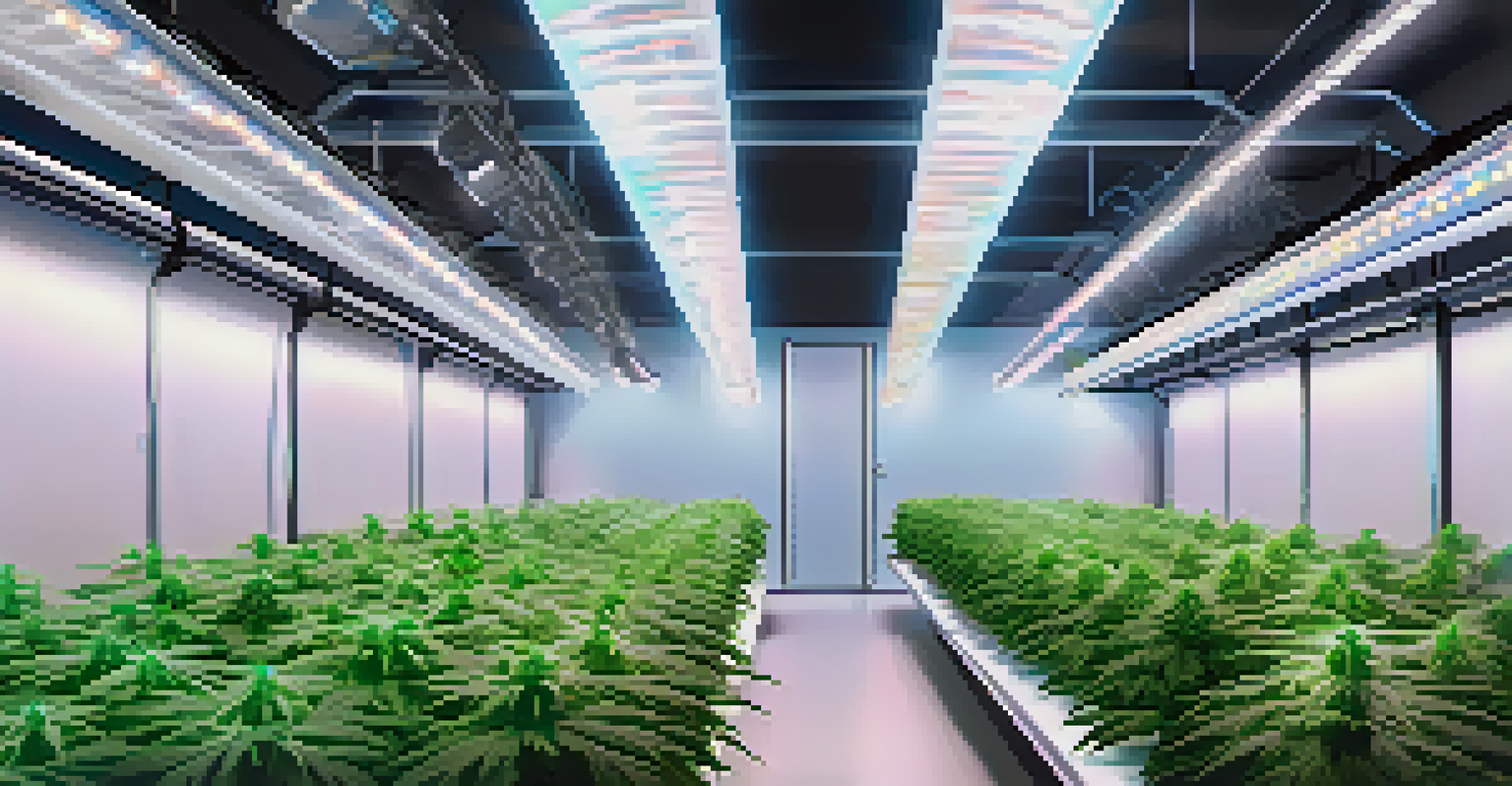Evaluating the Environmental Impacts of Cannabis Cultivation

Understanding Cannabis Cultivation and Its Growth
Cannabis cultivation has gained significant popularity as more regions legalize its use. This surge in demand has led to various cultivation methods, ranging from outdoor farming to high-tech indoor growing. Each method presents unique challenges and benefits that influence environmental impact. Understanding these different practices is crucial for evaluating their ecological footprints and sustainability.
The greatest threat to our planet is the belief that someone else will save it.
Outdoor cultivation relies heavily on natural sunlight and soil, which can be beneficial for the environment. However, it can also lead to land degradation and biodiversity loss if not managed properly. In contrast, indoor cultivation often requires massive energy inputs and artificial lighting, raising concerns about carbon footprints. This contrast highlights the importance of assessing cultivation methods in the context of their environmental implications.
As cannabis cultivation continues to expand, understanding its environmental impact becomes ever more critical. By examining the various growth methods, we can better appreciate the trade-offs involved and work towards sustainable practices that minimize harm to our planet.
Water Usage: A Critical Resource in Cannabis Farming
Water is a vital resource in cannabis cultivation, significantly influencing plant growth and yield. Depending on the cultivation method, water usage can vary dramatically, with some indoor farms consuming more than their outdoor counterparts. This discrepancy raises concerns, especially in regions already facing water scarcity. It’s essential to evaluate how different cultivation practices affect local water resources.

For instance, outdoor farms can utilize rainwater and natural irrigation, potentially reducing their overall water consumption. However, if not managed sustainably, these farms may lead to runoff, contributing to pollution in nearby water bodies. Meanwhile, indoor farms often implement hydroponic systems that can be more efficient but still require a substantial amount of water and energy. The choice of cultivation method directly impacts water sustainability.
Cultivation Methods Impact Ecology
Different cannabis cultivation methods, such as outdoor versus indoor growing, have distinct environmental impacts that need careful evaluation.
As we continue to assess the environmental impact of cannabis cultivation, water usage must remain a focal point. By adopting water-efficient practices and technologies, the cannabis industry can work towards minimizing its ecological footprint while still meeting consumer demands.
Soil Health: The Foundation of Sustainable Cultivation
Soil health is a critical factor in sustainable cannabis cultivation, influencing not only plant growth but also surrounding ecosystems. Healthy soil supports diverse microbial life, which can enhance nutrient availability and improve resilience against pests. However, intensive farming practices can lead to soil degradation, loss of fertility, and increased erosion, presenting significant environmental challenges.
Sustainability is not a destination but a journey that requires constant effort and commitment.
In outdoor cultivation, practices such as crop rotation and organic amendments can help maintain soil health. Conversely, indoor operations often rely on synthetic fertilizers, which can harm soil quality over time. Understanding the implications of soil management practices is essential in evaluating the overall sustainability of cannabis farming.
By prioritizing soil health, cannabis cultivators can create a more sustainable approach to farming. Implementing methods that enrich the soil not only benefits cannabis plants but also supports broader environmental goals, such as carbon sequestration and biodiversity preservation.
Energy Consumption: Evaluating Indoor Cultivation
Energy consumption is a significant concern in the cannabis industry, particularly with indoor cultivation methods. These operations often require extensive lighting, heating, and ventilation systems, leading to high energy demands and a considerable carbon footprint. As cannabis becomes more mainstream, addressing energy use is essential for sustainable growth.
Some indoor growers are beginning to adopt renewable energy sources, such as solar or wind power, to offset their energy consumption. However, the transition to sustainable energy practices is still in its infancy. Evaluating energy efficiency in cannabis cultivation can reveal opportunities for reducing environmental impact while maintaining productivity and quality.
Water Usage Affects Sustainability
Water consumption varies widely between cultivation practices, making efficient water management crucial for sustainability in cannabis farming.
As the industry evolves, prioritizing energy-efficient technologies and practices will be crucial. By embracing sustainable energy solutions, cannabis cultivators can not only reduce their ecological footprint but also create a more resilient and environmentally friendly industry.
Pesticides and Herbicides: Balancing Necessity and Safety
The use of pesticides and herbicides in cannabis cultivation is a topic of ongoing debate, particularly regarding their environmental impact. While these chemicals can be effective in managing pests and diseases, they often pose risks to non-target organisms and ecosystems. Striking a balance between effective pest management and ecological safety is essential for sustainable cannabis farming.
Some cultivators are turning to integrated pest management (IPM) practices that emphasize prevention and the use of natural predators instead of chemical treatments. This shift not only helps protect the environment but also aligns with consumer preferences for organic and sustainably grown products. However, transitioning to IPM requires education and commitment from growers.
As the cannabis market matures, the demand for responsible cultivation practices will likely rise. By focusing on safer pest management strategies, cultivators can minimize their ecological impact while meeting consumer expectations for environmentally friendly products.
Waste Management: Addressing Byproducts from Cultivation
Waste management is often overlooked in discussions about cannabis cultivation, yet it plays a significant role in the industry’s environmental impact. From plant trimmings to packaging materials, the waste generated can contribute to pollution if not handled responsibly. Understanding how different cultivation methods manage waste is essential for fostering sustainability in the industry.
Some growers are exploring innovative waste management solutions, such as composting plant materials and recycling packaging. These approaches not only reduce landfill contributions but also create opportunities for resource recovery. However, many cultivators still rely on conventional waste disposal methods, which can exacerbate environmental issues.
Regulations Shape Sustainable Practices
Clear and comprehensive regulations are vital for encouraging environmentally responsible practices in the growing cannabis industry.
As the cannabis industry continues to grow, effective waste management practices will become increasingly vital. By prioritizing sustainable waste solutions, cultivators can minimize their environmental footprint and contribute to a more circular economy.
The Role of Regulations in Sustainable Cannabis Cultivation
Regulations play a crucial role in shaping the environmental practices of cannabis cultivation. As legalization spreads, policymakers are tasked with creating guidelines that promote sustainable practices while ensuring public safety. Understanding the regulatory landscape is essential for both cultivators and consumers interested in the environmental implications of cannabis.
Some regions have implemented stringent environmental regulations that require cultivators to adopt sustainable practices, such as water conservation and waste management. These regulations can drive innovation and help foster a culture of responsibility within the industry. However, inconsistent regulations across regions can create challenges for cultivators striving to meet sustainability goals.

As the cannabis industry matures, the establishment of clear and comprehensive regulations will be essential for promoting sustainable practices. By aligning policy with environmental goals, we can support a cannabis industry that values ecological responsibility and community well-being.